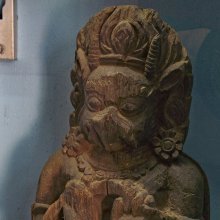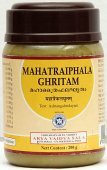Vyaghri, Vyāghrī: 10 definitions
Introduction:
Vyaghri means something in Buddhism, Pali, Hinduism, Sanskrit. If you want to know the exact meaning, history, etymology or English translation of this term then check out the descriptions on this page. Add your comment or reference to a book if you want to contribute to this summary article.
Images (photo gallery)
In Hinduism
Ayurveda (science of life)
Cikitsa (natural therapy and treatment for medical conditions)
Source: Wisdom Library: Ayurveda: CikitsaVyāghrī (व्याघ्री):—Another name for Kaṇṭakārī (Solanum xanthocarpum), a species of medicinal plant and used in the treatment of fever (jvara), as described in the Jvaracikitsā (or “the treatment of fever”) which is part of the 7th-century Mādhavacikitsā, a Sanskrit classical work on Āyurveda.
Nighantu (Synonyms and Characteristics of Drugs and technical terms)
Source: WorldCat: Rāj nighaṇṭuVyāghrī (व्याघ्री) is another name for Kaṇṭakārī, a medicinal plant identified with Solanum xanthacarpum, a synonym of Solanum virginianum L. (“surattense nightshade” or “Thai eggplant”) from the Solanaceae or “nightshades” family of flowering plants, according to verse 4.30-32 of the 13th-century Raj Nighantu or Rājanighaṇṭu. The fourth chapter (śatāhvādi-varga) of this book enumerates eighty varieties of small plants (pṛthu-kṣupa). Together with the names Vyāghrī and Kaṇṭakārī, there are a total of fourteen Sanskrit synonyms identified for this plant.
Kalpa (Formulas, Drug prescriptions and other Medicinal preparations)
Source: Shodhganga: Edition translation and critical study of yogasarasamgrahaVyāghrī (व्याघ्री) is another name for “Bṛhatī” and is dealt with in the 15th-century Yogasārasaṅgraha (Yogasara-saṅgraha) by Vāsudeva: an unpublished Keralite work representing an Ayurvedic compendium of medicinal recipes. The Yogasārasaṃgraha [mentioning vyāghrī] deals with entire recipes in the route of administration, and thus deals with the knowledge of pharmacy (bhaiṣajya-kalpanā) which is a branch of pharmacology (dravyaguṇa).

Āyurveda (आयुर्वेद, ayurveda) is a branch of Indian science dealing with medicine, herbalism, taxology, anatomy, surgery, alchemy and related topics. Traditional practice of Āyurveda in ancient India dates back to at least the first millenium BC. Literature is commonly written in Sanskrit using various poetic metres.
Purana and Itihasa (epic history)
Source: archive.org: Shiva Purana - English TranslationVyāghrī (व्याघ्री) refers to a “female tiger”, according to the Śivapurāṇa 2.3.54 (“Description of the duties of the chaste wife”).—Accordingly, as a Brahmin lady said to Pārvatī: “[...] She who forsakes her husband and secretly violates her fidelity is born as a she-owl of cruel nature wasting its days in the hollow of a tree. If she desires to beat her husband in retaliation, she becomes a tiger (vyāghrī) or a wild cat. She who ogles at another man becomes squint-eyed. She who partakes of sweet dish denying the same to her husband becomes a pig in the village or a wild goat eating its own dung. [...]”.
Source: Cologne Digital Sanskrit Dictionaries: The Purana IndexVyāghrī (व्याघ्री).—Wife of Jāmbavat; mother of Jāmbavatī.*
- * Brahmāṇḍa-purāṇa III. 7. 301.

The Purana (पुराण, purāṇas) refers to Sanskrit literature preserving ancient India’s vast cultural history, including historical legends, religious ceremonies, various arts and sciences. The eighteen mahapuranas total over 400,000 shlokas (metrical couplets) and date to at least several centuries BCE.
In Buddhism
Tibetan Buddhism (Vajrayana or tantric Buddhism)
Source: academia.edu: The Structure and Meanings of the Heruka Maṇḍala1) Vyāghrī (व्याघ्री) is the name of a Ḍākinī who, together with the Vīra (hero) named Vyāghra forms one of the 36 pairs situated in the Medinīcakra, according to the 10th century Ḍākārṇava chapter 15. Accordingly, the medinīcakra refers to one of the three divisions of the dharma-puṭa (‘dharma layer’), situated in the Herukamaṇḍala. The 36 pairs of Ḍākinīs [viz., Vyāghrī] and Vīras are yellow in color; the shapes of their faces are in accordance with their names; they have four arms; they hold a skull bowl, a skull staff, a small drum, and a knife.
2) Vyāghrī (व्याघ्री) is also the name of a Ḍākinī who, together with the Vīra (hero) named Vyāghra forms one of the 36 pairs situated in the Jalacakra, according to the same work. Accordingly, the jalacakra refers to one of the three divisions of the saṃbhoga-puṭa (‘enjoyment layer’), situated in the Herukamaṇḍala. The 36 pairs of Ḍākinīs [viz., Vyāghrī] and Vīras are white in color; the shapes of their faces are in accordance with their names; they have four arms; they hold a skull bowl, a skull staff, a small drum, and a knife..

Tibetan Buddhism includes schools such as Nyingma, Kadampa, Kagyu and Gelug. Their primary canon of literature is divided in two broad categories: The Kangyur, which consists of Buddha’s words, and the Tengyur, which includes commentaries from various sources. Esotericism and tantra techniques (vajrayāna) are collected indepently.
Languages of India and abroad
Sanskrit dictionary
Source: Cologne Digital Sanskrit Dictionaries: Cappeller Sanskrit-English DictionaryVyāghṛ (व्याघृ).—[Causative] the same. — Cf. abhi/ghṛta, vi/ghṛta.
Vyāghṛ is a Sanskrit compound consisting of the terms vyā and ghṛ (घृ).
Source: Cologne Digital Sanskrit Dictionaries: Monier-Williams Sanskrit-English Dictionary1) Vyāghṛ (व्याघृ):—[=vy-ā-√ghṛ] Caus. -ghārayati, to sprinkle round or over, besprinkle, [Taittirīya-saṃhitā; Śatapatha-brāhmaṇa]
2) Vyāghrī (व्याघ्री):—[from vyāghra > vyā-ghrā] a f. See [column]3.
3) [from vyā-ghrā] b f. of vyāghra, a tigress, [Śikṣā; Mahābhārata; Kāvya literature] etc.
4) [v.s. ...] Solanum jacquini, [Bhāvaprakāśa]
5) [v.s. ...] (with Buddhists) Name of a goddess, [Kālacakra]
Source: DDSA: Paia-sadda-mahannavo; a comprehensive Prakrit Hindi dictionary (S)Vyāghrī (व्याघ्री) in the Sanskrit language is related to the Prakrit word: Vagghī.
Sanskrit, also spelled संस्कृतम् (saṃskṛtam), is an ancient language of India commonly seen as the grandmother of the Indo-European language family (even English!). Closely allied with Prakrit and Pali, Sanskrit is more exhaustive in both grammar and terms and has the most extensive collection of literature in the world, greatly surpassing its sister-languages Greek and Latin.
Kannada-English dictionary
Source: Alar: Kannada-English corpusVyāghri (ವ್ಯಾಘ್ರಿ):—[noun] .
Kannada is a Dravidian language (as opposed to the Indo-European language family) mainly spoken in the southwestern region of India.
See also (Relevant definitions)
Starts with: Vyaghribaladi, Vyaghrijataka, Vyaghrini.
Ends with: Mahadvyaghri, Simhavyaghri.
Full-text: Vyaghra, Vyagharita, Kantakari, Vyagharana, Vagghi, Simhavyaghri, Mahaushadhi, Putradini, Tiger, Jalacakra, Medinicakra, Shuka, Putra.
Relevant text
Search found 13 books and stories containing Vyaghri, Vyā-ghṛ, Vya-ghri, Vyāghṛ, Vyāghrī, Vyāghri; (plurals include: Vyaghris, ghṛs, ghris, Vyāghṛs, Vyāghrīs, Vyāghris). You can also click to the full overview containing English textual excerpts. Below are direct links for the most relevant articles:
Rasa Jala Nidhi, vol 3: Metals, Gems and other substances (by Bhudeb Mookerjee)
Part 2 - Purification of Diamonds < [Chapter XIII - Gems (1): Vajra or Hiraka (diamond)]
The Mahavastu (great story) (by J. J. Jones)
Amarakoshodghatana of Kshirasvamin (study) (by A. Yamuna Devi)
Flora (7): Shrubs < [Chapter 5 - Aspects of Nature]
Manusmriti with the Commentary of Medhatithi (by Ganganatha Jha)
Verse 3.173 < [Section VIII - Śrāddhas]
The Agni Purana (by N. Gangadharan)
Chapter 69 - Mode of conducting the bathing festival (snāna)
Chapter 285 - The accomplished recipes that would revive the dead (mṛtasañjīvanī)
Chapter 363 - The words denoting earth, city, forest and herbs
Kavyamimamsa of Rajasekhara (Study) (by Debabrata Barai)
Part 4.2 - Ascertaintion and Division of Kāku (poetic intonation) < [Chapter 5 - Analyasis and Interpretations of the Kāvyamīmāṃsā]
Related products





